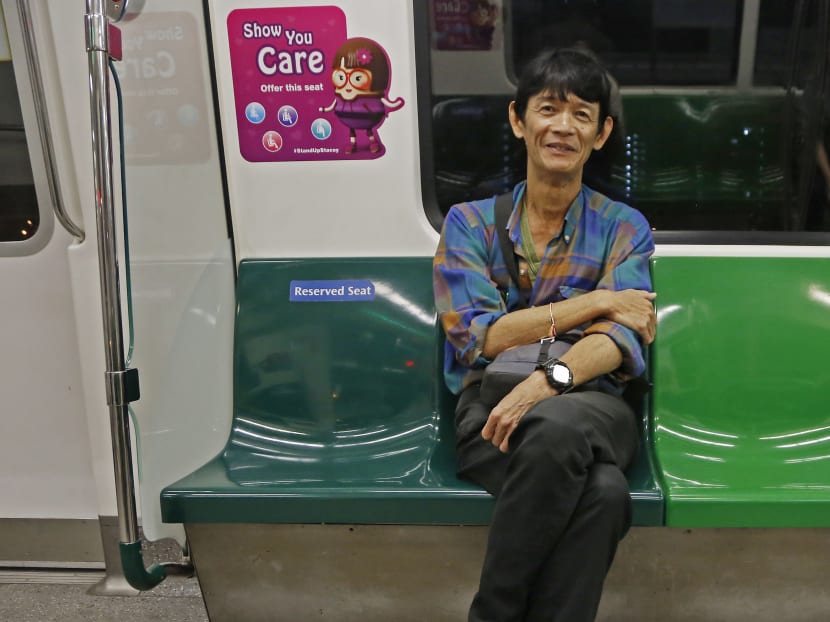Faces on the Subway: Braving high-risk work with discipline, good cheer
SINGAPORE — For the past 14 years, mechanical engineer Yeo Eng Huat has kept to a fixed morning routine on most weekdays. He wakes up at 3.30am, exercises at home, and heads to Tampines MRT Station at around 5am to catch the first train to work at Tuas.

Yeo Eng Huat — or Freddie, as he prefers to be called —wakes up at 3.30am to get to work from one end of the island to the other. Photo: Raj Nadarajan/TODAY
Every day, hundreds of thousands of passengers take the MRT, traversing across the island for work, school and leisure. The spate of disruptions and incidents, which the operators and authorities are looking to resolve, and the inconvenience caused to commuters, have brought into focus how the rail network has become a big part of our lives. So, too, are the countless faces we meet on the subway, some growing familiar over time and each with a story to tell.
In our Faces on the Subway weekly series, we speak to commuters who start their day while it is still dark, or call it a night when others are already fast asleep — people on the first or last train.
SINGAPORE — For the past 14 years, mechanical engineer Yeo Eng Huat has kept to a fixed morning routine on most weekdays. He wakes up at 3.30am, exercises at home, and heads to Tampines MRT Station at around 5am to catch the first train to work at Tuas.
The journey takes two hours by public transport, and while it may sound dreary and dull to stick to doing the same thing day after day, the physical and mental discipline is part of his life.
Mr Yeo designs and builds offshore oil rigs for a living, and has worked on more than 40 of them. The job requires him to climb high structures and lift heavy objects. “We work in confined spaces. Conditions are hot and dusty,” he said. “Sometimes it’s so dusty, or there is no light inside. It’s quite hard. But I’m used to it.”
As age catches up with the 56-year-old though, he has thought of retiring. His family encouraged him to do so a few years ago, but he chose to soldier on because “no one” can fill his position yet.
At a shipyard in Tuas, Mr Yeo works as an assistant section head and supervises about three to five workers at any given time. He also trains many of the young workers who are hired as assistant foremen under a three-year contract, immediately after they graduate from the Institute of Technical Education with mechanical, electrical, or marine and offshore engineering diplomas.
He believes that such programmes do help to get more young people to enter the industry, but he also noticed that many of them quickly lose interest. “In the first month, I put them in quite a tough situation. Their whole uniform will become black! This is a must because it’s a difficult environment.”
Asked how he himself lasted this long, he said: “I think perseverance is the key word. Everyone is different.”
BRIGHT SPARK
Mr Yeo is certainly “different” when he is among train commuters. In the early hours, most of the people waiting at the platform were seniors, some with their walking canes, as well as some younger workers sporting grumpy expressions and fiddling with their mobile phones.
A resident in Tampines for more than 30 years, Mr Yeo stood out as the bright and chirpy fellow who took the initiative to say “hello” and converse with fellow commuters. “I see the same faces every day, the old men and women… I’ve made friends with some of them,” he said.
To get to his workplace by 8am, he takes the train further up east to Pasir Ris station first, to ensure he gets a seat for the long journey on the East-West Line. When the train finally reaches Jurong East station, he alights to take the company bus to Tuas.
At work, Mr Yeo is keenly aware of the need to take great care when it comes to safety matters. He briefs the workers on what needs to be done and the safety procedures, and checks their health conditions, among other tasks.
“We have to stay focused at all times, as we are dealing with huge heavy equipment... If, on a particular day, we are working at a height, I will check which workers have a fear of heights before we assign duties. We also try to help the affected worker to overcome the phobia.
” Fires, explosions or accidents could happen at any moment. Mr Yeo remembered, for instance, a fatal accident that happened in 2006 at another shipyard, where he is occasionally called to work.
Three workers lost their lives and another three were injured when a part of a crane and its 185-tonne load came crashing down.
He had known some of those who died, having had lunch with them a few times before.
“We were all quite sad for the first week. Morale was low,” he said, his usual bright smile fading away. “I had no choice but to pick myself up because it was peak period at work.”
PARENTING DUTIES
Apart from work stresses, Mr Yeo also had to cope with family commitments when his three daughters were much younger.
“That time was really very tough,” he recalled. He or his wife — who has held various part-time jobs — had to rush to pick the children up from the childcare centre before it closed, or risked paying a fine.
This meant that, at times, he had to take a taxi from Tuas back to Tampines, or get his mother, who lives in Bedok, to help fetch them.
Mr Yeo stopped driving his own car when he began working in the shipyard, to cut down on growing fuel expenses. He never thought of moving to live nearer his workplace either because he wants to be near his mother.
These days, his lifestyle is not so hectic and he can get home by 8pm to have dinner with his family. His daughters are all in their 20s and holding down their own jobs in product design, marketing, and hospital management.
As a parent, he is not one to micromanage their time in school or work. “As long as the children grow up safe, I think it’s okay,” he said with a wave of his hand. “What they study, their projects and interests, it’s up to them. I try not to bother. There is no point forcing them.”
Before working in the shipyard, Mr Yeo had done mechanical and electrical engineering work in buildings when they were under construction, such as some of the first McDonald’s outlets in Singapore. Among them was the branch beside the Central Provident Fund service centre in Tampines, and he still frequently walks by it today.
However, he said that he would not go back to doing such work should he leave his present job, because he would like to try to do something different.
“Maybe I will do some designing work, see what I can come up with. I’m interested in designing innovative systems that can help improve things that people use daily... whatever I can work on,” he said with a laugh.








